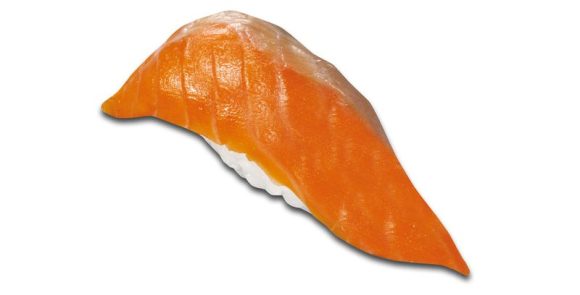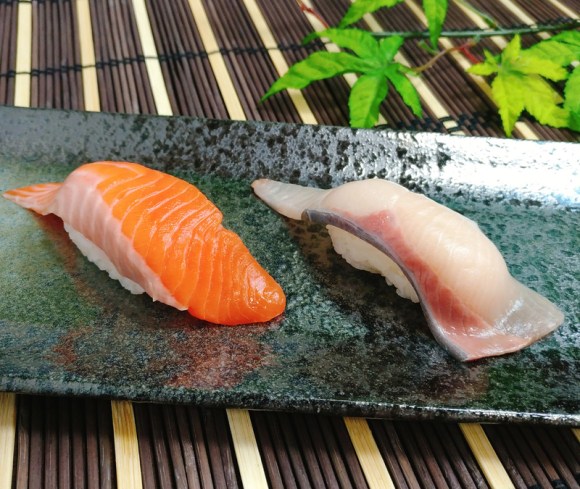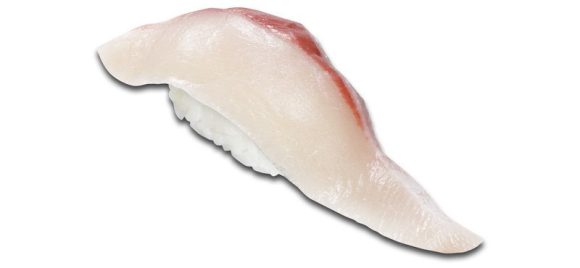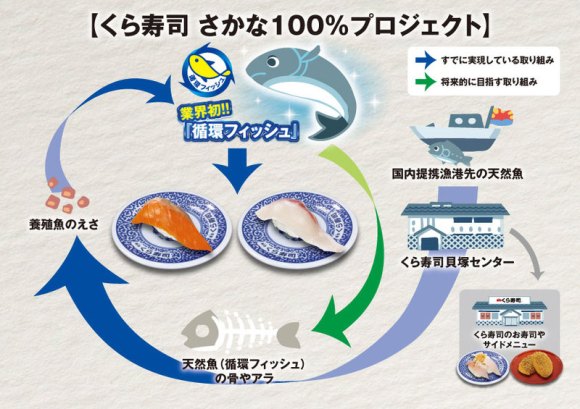
New project makes the popular chain the first of its kind to utilize 100 percent of the fish they acquire.
Among the various conveyor-belt sushi chains across Japan, Kurazushi is one of the most prominent, thanks in part to their creative offerings like sushi rice cola, sushi rice cola shaved ice, and sushi rice cola shaved ice flavored cream puffs.
This time, Kurazushi is serving up perhaps their most daring creation yet: salmon and amberjack sushi!
▼ Oh. Uh, that’s cool. I guess?
That might not sound so amazing until you understand how it arrives on the belt (next to a slice of blueberry cheesecake and the occasional Go-Pro).
Typically, these fish are caught in the ocean and then sent to one of Kurazushi’s processing facilities where they are deboned and cut up before being delivered to a nearby Kurazushi restaurant for the final touches.
However, this standard operation on such a large scale is quite wasteful resulting in 600 tons of unusable meat, bone, and other scraps every year. The challenge for Kurazushi is to find a way to cost-effectively handle this enormous pile of fish entrails.
Meanwhile, Japan’s fish farmers are also facing hard times. The skyrocketing cost of feed is making it hard for them to offer their aquaculture fish at competitive prices. If only there were 600 tons of stuff lying around somewhere that could be cheaply acquired and used for feed….
After someone connected those two dots, the so-called “Sakana 100% Project” was born as a joint effort by Kurazushi and the aquaculture industry to make some fishy lemonade out of their respective lemons.
The way the Sakana 100% Project works is simple: First, a fish is caught in the ocean and sent to processing. After the choice meat is removed, the remaining parts are then converted into feed which can be given to farmed fish. The farmed fish are then grown and sold back to Kurazushi, who in turn sell back the unusable parts as feed again for future generations of sushi.
▼ The figure-nine of life at Kurazushi
In other words Kurazushi is recycling its fish and thus using all of its parts with nothing going to waste.
For many reading this news, the concept of feeding fish to the same species of fish may sound alarming. It was certainly on the minds of many Japanese people upon learning about the Sakana 100% Project.
“Fish are cannibalistic by nature, so it should be okay.”
“Isn’t this what caused mad cow disease?”
“What is this, Xenogears?!”
“I think it’s a great idea and will make the industry more environmentally friendly.”
“It’s probably safer than fish from the ocean and all the chemicals they’ve been exposed to.”
It is hard to say if this process is totally safe, but unlike cattle, most fish are either carnivorous or omnivorous and known to engage in cannibalism. It’s at least a different set of circumstances, but still can’t help but bring up unpleasant thoughts of BSE in people’s minds.
Trying to overcome this stigma will be up to Kurazushi if they want to really get their Sakana 100% Project into full swing with a wider variety of seafood choices. Hopefully it is safe and if so, they can convince people of it, because it certainly looks like a great way to help reduce the burden on fish populations in the ocean, especially in large-scale enterprises like conveyor-belt sushi restaurants.
Source: Mainichi Shimbun, Kinisoku
Images: PR Wire




 Let’s go to a conveyor belt sushi restaurant — to enjoy delectable desserts!
Let’s go to a conveyor belt sushi restaurant — to enjoy delectable desserts! Can’t go to conveyor belt sushi? Major Japanese chain will bring the conveyor belt to you!
Can’t go to conveyor belt sushi? Major Japanese chain will bring the conveyor belt to you! Conveyor belt restaurant chain Kappa Sushi set to offer vegetable sushi at swanky new restaurants
Conveyor belt restaurant chain Kappa Sushi set to offer vegetable sushi at swanky new restaurants Which Japanese conveyor belt sushi chain has the best ikura sushi?【Taste test】
Which Japanese conveyor belt sushi chain has the best ikura sushi?【Taste test】 You can now get fugu, Japan’s poisonous blowfish, for under a buck at revolving sushi restaurants
You can now get fugu, Japan’s poisonous blowfish, for under a buck at revolving sushi restaurants Things get heavy with the Gold Lucky Bag from Village Vanguard
Things get heavy with the Gold Lucky Bag from Village Vanguard The Purple Lucky Bag from Village Vanguard is an extra-large waste of money
The Purple Lucky Bag from Village Vanguard is an extra-large waste of money Rakuten randomly offers 58 New Year’s osechi feasts in Japan, but did we get a star or a dud?
Rakuten randomly offers 58 New Year’s osechi feasts in Japan, but did we get a star or a dud? Japanese beef bowl chain Sukiya’s 2026 Smile Box lucky bag basically pays for itself
Japanese beef bowl chain Sukiya’s 2026 Smile Box lucky bag basically pays for itself Top Japanese cosplayer Enako returns to Comiket after 6 years, creates mayhem with admirers
Top Japanese cosplayer Enako returns to Comiket after 6 years, creates mayhem with admirers Majority of Japanese mayors say foreign residents are essential but most see good and bad effects
Majority of Japanese mayors say foreign residents are essential but most see good and bad effects Starbucks Japan ready to get Year of the Horse started with adorable drinkware and plushies【Pics】
Starbucks Japan ready to get Year of the Horse started with adorable drinkware and plushies【Pics】 Nearly one in ten young adults living in Japan isn’t ethnically Japanese, statistics show
Nearly one in ten young adults living in Japan isn’t ethnically Japanese, statistics show Tokyo’s Shibuya ward sets up English information desk to help foreigners find nightlife options
Tokyo’s Shibuya ward sets up English information desk to help foreigners find nightlife options Japan’s only blue old-school post box: Where is it and why is it there?
Japan’s only blue old-school post box: Where is it and why is it there? Hayao Miyazaki says Happy New Year to Studio Ghibli fans with new art for Year of the Horse
Hayao Miyazaki says Happy New Year to Studio Ghibli fans with new art for Year of the Horse Cup Noodle tries an authentic Jiro-style ramen, but something’s not quite right
Cup Noodle tries an authentic Jiro-style ramen, but something’s not quite right The best Starbucks Japan Frappuccinos we want to drink again in 2026
The best Starbucks Japan Frappuccinos we want to drink again in 2026 We revisited Sweets Paradise after a decade to see if Japan’s dessert buffet still delivers
We revisited Sweets Paradise after a decade to see if Japan’s dessert buffet still delivers That time Seiji called JASRAC to ask why he didn’t get paid royalties for his song being on TV
That time Seiji called JASRAC to ask why he didn’t get paid royalties for his song being on TV We found possibly the quietest Japanese-style hotel in Tokyo’s bustling Shinjuku district
We found possibly the quietest Japanese-style hotel in Tokyo’s bustling Shinjuku district Pizza Hut Japan’s hot lucky bags are perfect for a New Year’s pizza party
Pizza Hut Japan’s hot lucky bags are perfect for a New Year’s pizza party Japan’s oldest largetooth sawfish in captivity back on display in Mie Prefecture
Japan’s oldest largetooth sawfish in captivity back on display in Mie Prefecture 7-Eleven Japan starts new temporary luggage storage service in over 300 branches
7-Eleven Japan starts new temporary luggage storage service in over 300 branches Disillusionment at Tsukiji’s tourist-target prices led us to a great ramen restaurant in Tokyo
Disillusionment at Tsukiji’s tourist-target prices led us to a great ramen restaurant in Tokyo Starbucks teams up with 166-year-old Kyoto doll maker for Year of the Horse decorations【Photos】
Starbucks teams up with 166-year-old Kyoto doll maker for Year of the Horse decorations【Photos】 Tokyo considering law requiring more trash cans following litter increase in heavily touristed area
Tokyo considering law requiring more trash cans following litter increase in heavily touristed area Tokyo’s Tsukiji sushi neighborhood asks tour groups to stay away for the rest of the month
Tokyo’s Tsukiji sushi neighborhood asks tour groups to stay away for the rest of the month Tokyo event lets you travel back in time, for free, to celebrate 100 years since Showa era start
Tokyo event lets you travel back in time, for free, to celebrate 100 years since Showa era start Japan may add Japanese language proficiency, lifestyle classes to permanent foreign resident requirements
Japan may add Japanese language proficiency, lifestyle classes to permanent foreign resident requirements Sanrio theme park in Japan announces plans to expand into a Sanrio resort
Sanrio theme park in Japan announces plans to expand into a Sanrio resort Stamina-destroying “Paralysis Noodles” are Tokyo’s newest over-the-top ramen innovation
Stamina-destroying “Paralysis Noodles” are Tokyo’s newest over-the-top ramen innovation Survey asks foreign tourists what bothered them in Japan, more than half gave same answer
Survey asks foreign tourists what bothered them in Japan, more than half gave same answer Japan’s human washing machines will go on sale to general public, demos to be held in Tokyo
Japan’s human washing machines will go on sale to general public, demos to be held in Tokyo Japan’s deadliest food claims more victims, but why do people keep eating it for New Year’s?
Japan’s deadliest food claims more victims, but why do people keep eating it for New Year’s? We deeply regret going into this tunnel on our walk in the mountains of Japan
We deeply regret going into this tunnel on our walk in the mountains of Japan Studio Ghibli releases Kodama forest spirits from Princess Mononoke to light up your home
Studio Ghibli releases Kodama forest spirits from Princess Mononoke to light up your home Major Japanese hotel chain says reservations via overseas booking sites may not be valid
Major Japanese hotel chain says reservations via overseas booking sites may not be valid Put sesame oil in your coffee? Japanese maker says it’s the best way to start your day【Taste test】
Put sesame oil in your coffee? Japanese maker says it’s the best way to start your day【Taste test】 No more using real katana for tourism activities, Japan’s National Police Agency says
No more using real katana for tourism activities, Japan’s National Police Agency says Starbucks Japan reveals new sakura drinkware collection, inspired by evening cherry blossoms
Starbucks Japan reveals new sakura drinkware collection, inspired by evening cherry blossoms Updated cherry blossom forecast shows extra-long sakura season for Japan this year
Updated cherry blossom forecast shows extra-long sakura season for Japan this year We visit “the best conveyor belt sushi restaurant in Japan”
We visit “the best conveyor belt sushi restaurant in Japan” Which Japanese conveyor belt sushi chain has the best mackerel sushi?【Taste test】
Which Japanese conveyor belt sushi chain has the best mackerel sushi?【Taste test】 A funny thing happened at the conveyor belt sushi shop…
A funny thing happened at the conveyor belt sushi shop… Which Japanese conveyor belt sushi chain has the best salmon sushi?【Taste test】
Which Japanese conveyor belt sushi chain has the best salmon sushi?【Taste test】 Which Japanese conveyor belt sushi chain has the best aburi salmon sushi?【Taste test】
Which Japanese conveyor belt sushi chain has the best aburi salmon sushi?【Taste test】 Pileup on sushi conveyor belt causes chaos for diners at restaurant chain in Japan
Pileup on sushi conveyor belt causes chaos for diners at restaurant chain in Japan Which Japanese conveyor belt sushi chain has the best bintoro sushi?【Taste test】
Which Japanese conveyor belt sushi chain has the best bintoro sushi?【Taste test】 Kura Sushi adds new cake party train to conveyor belts at select restaurants
Kura Sushi adds new cake party train to conveyor belts at select restaurants Which Japanese conveyor belt sushi chain has the best yellowtail sushi?【Taste test】
Which Japanese conveyor belt sushi chain has the best yellowtail sushi?【Taste test】 Which Japanese conveyor belt sushi chain has the best hamburger steak sushi?【Taste test】
Which Japanese conveyor belt sushi chain has the best hamburger steak sushi?【Taste test】 How to have a great meal at conveyer belt sushi chain Kura Sushi even if you hate raw fish
How to have a great meal at conveyer belt sushi chain Kura Sushi even if you hate raw fish Which Japanese conveyor belt sushi chain has the best salad sushi?【Taste test】
Which Japanese conveyor belt sushi chain has the best salad sushi?【Taste test】 Which Japanese conveyor belt sushi chain has the best iwashi sardine sushi?【Taste test】
Which Japanese conveyor belt sushi chain has the best iwashi sardine sushi?【Taste test】 Which Japanese conveyor belt sushi chain has the best tai sushi?【Taste test】
Which Japanese conveyor belt sushi chain has the best tai sushi?【Taste test】 Japanese conveyor belt sushi restaurant chain makes sushi with the help of artificial intelligence
Japanese conveyor belt sushi restaurant chain makes sushi with the help of artificial intelligence Is it the end of Japan’s conveyor belt sushi as we know it?
Is it the end of Japan’s conveyor belt sushi as we know it? Which Japanese conveyor belt sushi chain has the best prawn sushi?【Taste test】
Which Japanese conveyor belt sushi chain has the best prawn sushi?【Taste test】
Leave a Reply